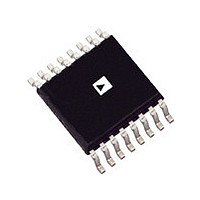AD7811YRU-REEL Analog Devices Inc, AD7811YRU-REEL Datasheet - Page 11

AD7811YRU-REEL
Manufacturer Part Number
AD7811YRU-REEL
Description
Manufacturer
Analog Devices Inc
Datasheet
1.AD7811YRU-REEL.pdf
(19 pages)
Specifications of AD7811YRU-REEL
Number Of Elements
1
Resolution
10Bit
Architecture
SAR
Sample Rate
350KSPS
Input Polarity
Unipolar
Input Type
Voltage
Rated Input Volt
2.5/5V
Differential Input
Yes
Power Supply Requirement
Single
Single Supply Voltage (typ)
3.3/5V
Single Supply Voltage (min)
2.7V
Single Supply Voltage (max)
5.5V
Dual Supply Voltage (typ)
Not RequiredV
Dual Supply Voltage (min)
Not RequiredV
Dual Supply Voltage (max)
Not RequiredV
Power Dissipation
10.5mW
Differential Linearity Error
±1LSB
Integral Nonlinearity Error
±1LSB
Operating Temp Range
-40C to 105C
Operating Temperature Classification
Industrial
Mounting
Surface Mount
Pin Count
16
Package Type
TSSOP
Lead Free Status / Rohs Status
Not Compliant
Available stocks
Company
Part Number
Manufacturer
Quantity
Price
Company:
Part Number:
AD7811YRU-REEL
Manufacturer:
AD
Quantity:
3 753
An example of the pseudo differential scheme using the AD7811
is shown in Figure 6. The relevant bits in the AD7811 Control
Register are set as follows DIF/SGL = 1, CH1 = CH2 = 0, i.e.,
V
applied to V
pling capacitor is connected to V
AGND as described in the Converter Operation section. This
input scheme can be used to remove offsets that exist in a sys-
tem. For example, if a system had an offset of 0.5 V the offset
could be applied to V
the effect of offsetting the input span by 0.5 V. It is only pos-
sible to offset the input span when the reference voltage is less
than V
When using the pseudo differential input scheme the signal on
V
sion process. If the signal on V
conversion result will be incorrect. In single-ended mode the
sampling capacitor is always connected to AGND during con-
version. Figure 7 shows the AD7811/AD7812 pseudo differen-
tial input being used to make a unipolar dc current measurement.
A sense resistor is used to convert the current to a voltage and
the voltage is applied to the differential input as shown.
DC Acquisition Time
The ADC starts a new acquisition phase at the end of a conver-
sion and ends on the falling edge of the CONVST signal. At the
end of a conversion a settling time is associated with the sam-
pling circuit. This settling time lasts approximately 100 ns. The
analog signal on V
time. Therefore, the minimum acquisition time needed is
approximately 100 ns.
V
IN1
IN2
IN1
V
pseudo differential with respect to V
must not vary by more than a 1/2 LSB during the conver-
OFFSET
V
DD
OFFSET
–OFFSET.
IN1
V
V
V
IN1
IN2
DD
but in the pseudo differential scheme the sam-
IN+
V
V
IN–
IN+
IN2
R
is also being acquired during this settling
SENSE
and the signal applied to V
V
R
DD
L
CONVERSION
/3
CAPACITOR
SAMPLING
PHASE
IN2
IN2
varies during conversion, the
during conversion and not
AD7811/
AD7812
V
V
COMPARATOR
IN+
IN2
IN–
. The signal is
REDISTRIBUTION
IN1
CONTROL
CHARGE
LOGIC
. This has
CLOCK
DAC
OSC
Figure 8 shows the equivalent charging circuit for the sampling
capacitor when the ADC is in its acquisition phase. R2 repre-
sents the source impedance of a buffer amplifier or resistive
network; R1 is an internal multiplexer resistance, and C1 is the
sampling capacitor. During the acquisition phase the sampling
capacitor must be charged to within a 1/2 LSB of its final value.
The time it takes to charge the sampling capacitor (T
given by the following formula:
For small values of source impedance, the settling time associ-
ated with the sampling circuit (100 ns) is, in effect, the acquisi-
tion time of the ADC. For example, with a source impedance
(R2) of 10 Ω the charge time for the sampling capacitor is
approximately 4 ns. The charge time becomes significant for
source impedances of 2 kΩ and greater.
AC Acquisition Time
In ac applications it is recommended to always buffer analog
input signals. The source impedance of the drive circuitry must
be kept as low as possible to minimize the acquisition time of
the ADC. Large values of source impedance will cause the THD
to degrade at high throughput rates. In addition, better perfor-
mance can generally be achieved by using an External 1 nF
capacitor on V
ON-CHIP REFERENCE
The AD7811 and AD7812 have an on-chip 2.5 V reference
circuit. The schematic in Figure 9 shows how the reference
circuit is implemented. A 1.23 V bandgap reference is gained up
to provide a 2.5 V ± 2% reference voltage. The on-chip refer-
ence is not available externally (SW2 is open). An external refer-
ence (1.2 V to V
order to use an external reference the EXTREF bit in the con-
trol register (Bit 0) must first be set to a Logic 1. When EXTREF
is set to a Logic 1 SW2 will close, SW3 will open and the ampli-
fier will power down. This will reduce the current consumption
of the part by about 1 mA. It is possible to use two different
reference voltages by selecting the on-chip reference or external
reference.
CAPACITOR
EXTERNAL
R2
T
IN
CHARGE
.
1.23V
DD
) can be applied at the V
SW1
C
AGND
REF
V
IN+
= 7.6 × (R2 + 125 Ω) × 3.5 pF
AD7811/AD7812
SW3
125
R1
3.5pF
C1
REF
pin. However in
SAMPLING
CAPACITOR
V
REF
SW2
CHARGE
7pF
2.5V
) is














